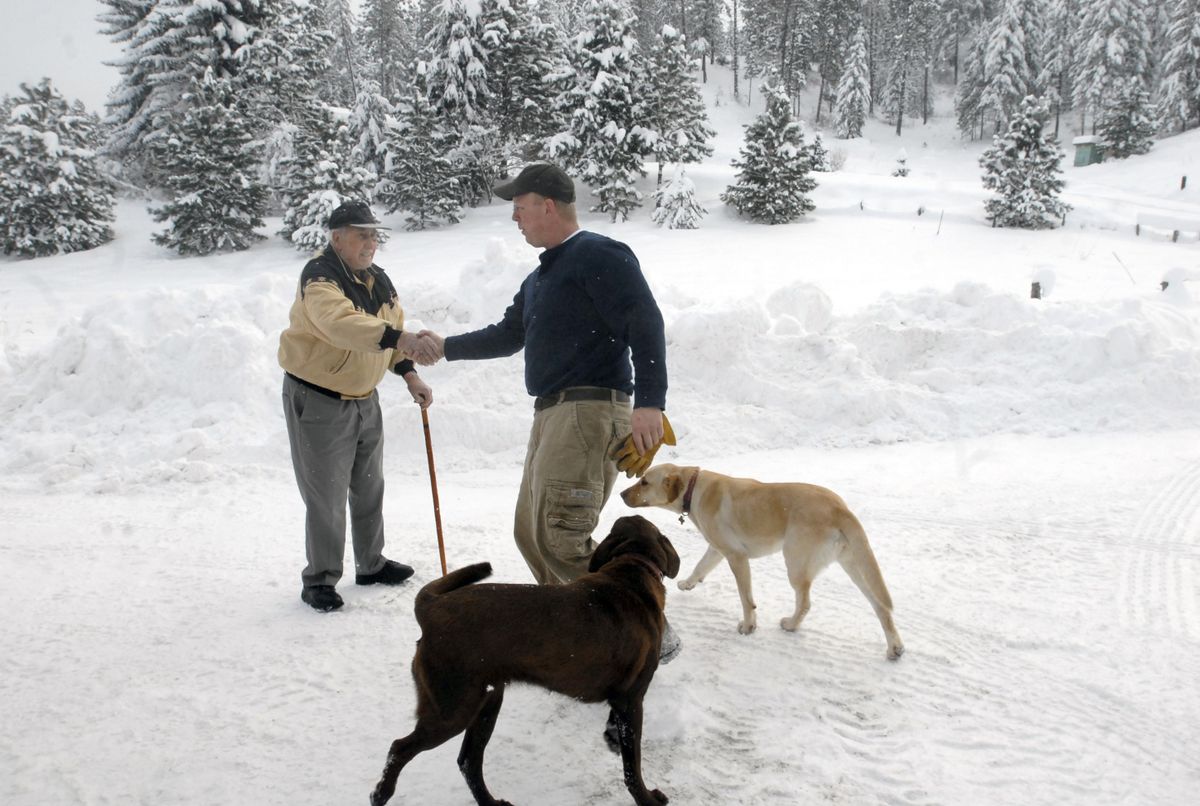Ski-Mor memories
Former ski resort fun winter playground

Ski-Mor is a chapter of Spokane Valley history almost forgotten.
One of the area’s first ski resorts, it operated for nine seasons where 44th Avenue meets the east slope of Browne Mountain in the Ponderosa neighborhood.
Entrepreneurs William Schafer and his son-in-law, Orrin Torrey, developed Ski-Mor as a winter playground in 1933. The 110-acre property had been in the Schafer family since 1850.
“It was something special,” said Marilyn Rider, Torrey’s 74-year-old daughter. “There was nothing else like it here.”
The resort, open on weekends and holidays, featured an Olympic-sized ski jump, a smaller ski jump, an outdoor ice skating rink, toboggan run and indoor ski lodge.
The toboggan run was a long chute, using planks of wood as the sides to stabilize the snow.
“We would get five or six kids on and go down that thing,” said longtime Valley resident Lloyd Phillips, 84. “I don’t know how fast we were going but we would go a-flying.”
Phillips, along with his friend Martha Eachon, were two neighborhood kids who worked and played at the resort.
Phillips was 8 and Eachon, 9, when it opened during the Great Depression. The kids did not have any money to use the facility.
“We were so poor we didn’t have skis, skates or anything,” Phillips explained.
The Schafers compensated the kids with food and use of the resort in exchange for working small jobs.
“We would get a hamburger and a Coke,” said Eachon, 85. “That was our pay. We thought that was great.”
“(The Schafers) were so good to us,” Phillips said. “Mrs. Schafer created jobs for us. My job was sweeping the ice every hour to two. I would come in and (Mrs. Schafer) would make me a hamburger and cocoa.”
Eachon helped cook hamburgers for the hungry skiers. She would start up the gas grill, make small balls of hamburger using a ladle, and then pound the balls into the right size patties.
“Some (hamburger patties) were larger than others,” Eachon laughs. “It was work, but fun work.”
When they finished working, the kids enjoyed the resort free of charge. Phillips remembers riding a modified bicycle down the bunny hill. The bike had runners instead of tires.
“Riding those bikes was unreal,” Phillips said. “They had no brakes. You just went down the hill a-flying and either fell off, hit something or made it clean down into the field.”
Phillips spent most of his time skating. He taught himself to skate using metal blades tied to his boots. To this day, the ice skating pond is one of his favorite Ski-Mor memories.
“I loved to skate,” Phillips remembers. “I would skate for hours.”
Rider and her twin sister, Carolyn, were very young when their parents operated the resort but would get to come occasionally to ice skate.
“It was real magical,” said Rider, who still lives in the Valley. “We would skate at night and the lights from the lodge lit up the ice.”
Building the resort took years of hard work. Schafer and Torrey cleared the wooded hillside, built the ski lodge that housed a large rock fireplace and kitchen, and dug the hole for the ice skating pond, which was fed with spring water year round.
Eachon remembers her father, Charlie Gorremans, helping clear the trees with a hand ax, and then hauling the logs down the mountain side with his horses.
Rider believes the idea for the resort came after her father visited his sister in Leavenworth, Wash.
“My father was an innovator,” Rider said. “He was always inventing something. I believe he saw someone skiing on the West Coast and thought they could do something similar.”
She also remembers her father creating a special way to haul toboggan riders up the hill. She thinks he based the designed on an escalator that her mother, Stella, saw in Denver.
“My mom described to him what she saw,” Rider recalls. “He could create anything.”
According to Florence Boutwell’s book, “The Spokane Valley, Volume 2, A History of the Growing Years,” Torrey, who was also a blacksmith, developed the area’s first rope tow. He powered it with a Chevrolet engine.
Phillips and Eachon both recall the resort attracting large crowds. There was a parking lot on the west side of the resort that Phillips estimates accommodated 50 to 100 cars. He remembers cars lining up along both sides of 44th Avenue, especially when the resort hosted the Northwest Ski Championships.
“It was standing room only,” Phillips said of watching the event. “I wouldn’t miss them. I remember I couldn’t believe how these guys could come down the hill so fast, fly out over an excess of 350 feet, land and not fall down.”
In 1942, the resort closed. Boutwell’s book cites one reason as the snow “always coming at the wrong time.” Rider also believes a lawsuit over a toboggan accident is another factor. The owners eventually sold the property.